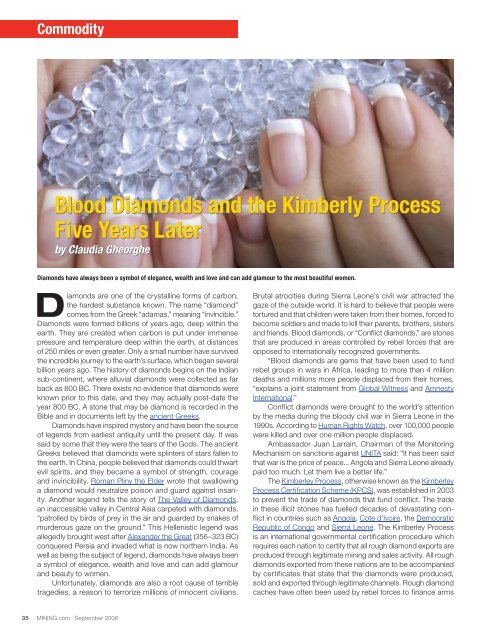Create successful ePaper yourself
Turn your PDF publications into a flip-book with our unique Google optimized e-Paper software.
Commodity<br />
Blood Diamonds and the Kimberly Process<br />
Five Years Later<br />
by Claudia Gheorghe<br />
Diamonds have always been a symbol of elegance, wealth and love and can add glamour to the most beautiful women.<br />
Diamonds are one of the crystalline forms of carbon,<br />
the hardest substance known. The name “diamond”<br />
<strong>com</strong>es from the Greek “adamas,” meaning “invincible.”<br />
Diamonds were formed billions of years ago, deep within the<br />
earth. They are created when carbon is put under immense<br />
pressure and temperature deep within the earth, at distances<br />
of 250 miles or even greater. Only a small number have survived<br />
the incredible journey to the earth’s surface, which began several<br />
billion years ago. The history of diamonds begins on the Indian<br />
sub-continent, where alluvial diamonds were collected as far<br />
back as 800 BC. There exists no evidence that diamonds were<br />
known prior to this date, and they may actually post-date the<br />
year 800 BC. A stone that may be diamond is recorded in the<br />
Bible and in documents left by the ancient Greeks.<br />
Diamonds have inspired mystery and have been the source<br />
of legends from earliest antiquity until the present day. It was<br />
said by some that they were the tears of the Gods. The ancient<br />
Greeks believed that diamonds were splinters of stars fallen to<br />
the earth. In China, people believed that diamonds could thwart<br />
evil spirits, and they became a symbol of strength, courage<br />
and invincibility. Roman Pliny the Elder wrote that swallowing<br />
a diamond would neutralize poison and guard against insanity.<br />
Another legend tells the story of The Valley of Diamonds,<br />
an inaccessible valley in Central Asia carpeted with diamonds,<br />
“patrolled by birds of prey in the air and guarded by snakes of<br />
murderous gaze on the ground.” This Hellenistic legend was<br />
allegedly brought west after Alexander the Great (356–323 BC)<br />
conquered Persia and invaded what is now northern India. As<br />
well as being the subject of legend, diamonds have always been<br />
a symbol of elegance, wealth and love and can add glamour<br />
and beauty to women.<br />
Unfortunately, diamonds are also a root cause of terrible<br />
tragedies, a reason to terrorize millions of innocent civilians.<br />
35 <strong>MINING</strong>.<strong>com</strong> September 2008<br />
Brutal atrocities during Sierra Leone’s civil war attracted the<br />
gaze of the outside world. It is hard to believe that people were<br />
tortured and that children were taken from their homes, forced to<br />
be<strong>com</strong>e soldiers and made to kill their parents, brothers, sisters<br />
and friends. Blood diamonds, or “Conflict diamonds,” are stones<br />
that are produced in areas controlled by rebel forces that are<br />
opposed to internationally recognized governments.<br />
“Blood diamonds are gems that have been used to fund<br />
rebel groups in wars in Africa, leading to more than 4 million<br />
deaths and millions more people displaced from their homes,<br />
“explains a joint statement from Global Witness and Amnesty<br />
International.”<br />
Conflict diamonds were brought to the world’s attention<br />
by the media during the bloody civil war in Sierra Leone in the<br />
1990s. According to Human Rights Watch, over 100,000 people<br />
were killed and over one million people displaced.<br />
Ambassador Juan Larrain, Chairman of the Monitoring<br />
Mechanism on sanctions against UNITA said: “It has been said<br />
that war is the price of peace... Angola and Sierra Leone already<br />
paid too much. Let them live a better life.”<br />
The Kimberley Process, otherwise known as the Kimberley<br />
Process Certification Scheme (KPCS), was established in 2003<br />
to prevent the trade of diamonds that fund conflict. The trade<br />
in these illicit stones has fuelled decades of devastating conflict<br />
in countries such as Angola, Cote d’Ivoire, the Democratic<br />
Republic of Congo and Sierra Leone. The Kimberley Process<br />
is an international governmental certification procedure which<br />
requires each nation to certify that all rough diamond exports are<br />
produced through legitimate mining and sales activity. All rough<br />
diamonds exported from these nations are to be ac<strong>com</strong>panied<br />
by certificates that state that the diamonds were produced,<br />
sold and exported through legitimate channels. Rough diamond<br />
caches have often been used by rebel forces to finance arms




